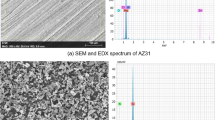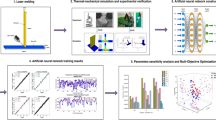Abstract
Precipitation-hardened Cu-0.804Cr-0.063Zr alloy is a potential material to be used for the fabrication of heat sinks in International Thermonuclear Experimental Reactor (ITER) applications. The softening temperature of these alloys is 500 °C, which makes it suitable for the fabrication of components subjected to high heat flux. During welding, the precipitates get completely dissolved in the melted zone, which results in lower hardness and softening temperature. The aim of this study was to understand the effects of electron beam welding (EBW) on weld bead geometry and mechanical properties of this alloy. Accelerating voltage, beam current, welding speed, and focusing distance were selected as input variables, and bead geometric parameters like bead width, bead penetration, and microhardness values of the fusion and heat-affected zones were considered as outputs. Statistical regression analysis was conducted to determine input-output relationships. All the above input parameters were found to have significant contributions toward bead penetration and microhardness of fusion zone. However, accelerating voltage did not have significant contribution toward bead width. Optimization was done to obtain minimum weldment area after satisfying the conditions of maximum bead penetration and minimum deviation of the hardness of fusion zone from that of parent material. This constrained optimization problem was solved using a genetic algorithm along with a penalty function approach for handling the functional constraints. A good agreement was obtained between the results predicted by the optimization tool and that of real experiments. Thus, the genetic algorithm (GA) could accurately establish input-output relationships of this process.
Similar content being viewed by others
References
Durocher A, Lipa M, Chappius P, Schlosser J, Huber T, Schedler B (2002) Tore Supra experience of CuCrZr electron beam welding. J Nucl Mater 307–311:1554–7
Batra IS, Dey GK, Kulkarni UD, Banerjee S (2001) Microstructure and properties of a Cu-Cr-Zr alloy. J Nucl Mater 299:91–100
Li M, Zinkle SJ (2012) Physical and mechanical properties of copper and copper alloys. In: Konings R.J.M., (ed.) Amsterdam: Elsevier. Compr Nucl Mater 4:667–90
Robbie MBO, Hamilton N, Wood J, Galloway A, Milnes J, Katramados I (2011) Observations on the post-mortem investigation of electron beam welds and other micro-structural features of JET hypervapotron. Fusion Eng Des 86:2394–7
Chi CT, Chao CG (2007) Characterization on electron beam welds and parameters for AZ31B-F extrusive plates. J Mater Process Technol 182:369–73
Ganjigatti JP, Pratihar DK, Roy Choudhury A (2007) Global versus cluster-wise regression analyses for prediction of bead geometry in MIG welding process. J Mater Process Technol 189(1):352–66
Gunaraj V, Murugan N (2000) Prediction and optimization of weld bead volume for the submerged arc process—Part 1. Weld J 78:286–94
Benyounis KY, Olabi AG, Hashmi MSJ (2005) Effect of laser welding parameters on the heat input and weld-bead profile. J Mater Process Technol 64–165:978–85
Kim D, Rhee S, Park H (2002) Modeling and optimization of a GMA welding process by genetic algorithm and response surface methodology. Int J Prod Res 40(7):1699–711
Koleva E (2001) Statistical modelling and computer programs for optimization of the electron beam welding of stainless steel. Vac 62(2):151–7
Dey V, Pratihar DK, Datta GL, Jha MN, Saha TK, Bapat AV (2009) Optimization of bead geometry in electron beam welding using a genetic algorithm. J Mater Process Technol 209(3):151–1157
Jha MN, Pratihar DK, Dey V, Saha TK, Bapat AV (2011) Study on electron beam butt welding of austenitic stainless steel 304 plates and its input-output modeling using neural networks. Proc Inst Mech Eng Part B: J Eng Manuf 225:2051–70
Jha MN, Pratihar DK, Bapat AV, Dey V, Ali M, Bagchi AC (2013) Knowledge-based systems using neural networks for electron beam welding process of reactive material (Zircaloy-4). J Int Manuf. doi:10.1007/s10845-013-0732-3
Schlosser J, Chappuis P, Chatelier M, Durocher A, Guilheim D, Lipa M, Mitteau R, Plochl L, Tonon G, Tsitrone E (1998) Design, fabrication and testing of an improved high heat flux element, experience feedback on steady state plasma facing components in Tore Supra. Fusion Eng Des 39–40:235–40
Durocher A, Ayrault D, Chagnot C, Lipa M, Saikaly W (2007) CuCrZr alloy hot cracking during electron beam welding. J Nucl Mater 367–370:1208–12
Lipa M, Durocher A, Tivey R, Huber T, Schedler B, Weigert J (2005) The use of copper alloy CuCrZr as a structural material for actively cooled plasma facing and in vessel components. Fusion Eng Des 75–79:469–73
Meher J (2014) Electron beam butt welding of Cu-Cr-Zr Alloy: Experiments, modeling and analysis. M. Tech. Thesis, Indian Institute of Technology Kharagpur, India
Montgomery DC (2001) Design and Analysis of Experiments. John Wiley, New York
Minitab Inc user manual of MINITAB statistical software. Release 15 State College PA 16801 USA, 2007 (http: // www.minitab.com)
Holland JH (1975) Adaption in natural and artificial systems. The University of Michigan Press, USA
Pratihar DK (2014) Soft computing: fundamentals and applications. Narosa Publishing House Pvt. Ltd., New Delhi
Schiller S, Heisig U, Panzer S (1982) Electron beam technology. A Wiley Inter science Publication, New York
Kannatey E, Jr A (2009) Principles of laser materials processing. John Willey & Sons, Inc., Hoboken
Author information
Authors and Affiliations
Corresponding author
Rights and permissions
About this article
Cite this article
Kanigalpula, P.K.C., Pratihar, D.K., Jha, M.N. et al. Experimental investigations, input-output modeling and optimization for electron beam welding of Cu-Cr-Zr alloy plates. Int J Adv Manuf Technol 85, 711–726 (2016). https://doi.org/10.1007/s00170-015-7964-7
Received:
Accepted:
Published:
Issue Date:
DOI: https://doi.org/10.1007/s00170-015-7964-7




